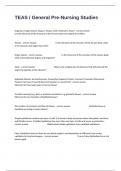TEAS / General Pre-Nursing Studies
Organism, Organ System, Organs, Tissues, Cells, Molecules, Atoms - correct answer
List the hierarchy of the structure of the human body from largest to smallest
Tissues - correct answer In the hierarchy of the structure of the human body, what
is the structure just larger than Cells?
Organ System - correct answer In the hierarchy of the structure of the human body,
what comes between Organs and Organism?
Atom - correct answer What is the smallest part of elements that still retain all the
original properties of the element?
Epithelial (Absorb, Secrete/Excrete), Connective (Support, Protect, Connect), Muscular (Movement,
Posture), Nervous (Transmit Electrical Impulses or secrete NT) - correct answer
What are the four basic types of human tissue?
Provides covering (e.g. skin) or produces secretions (e.g. glandular tissue) - correct answer
What are the two functions of Epithelial tissue?
The number of cell layers and the cell shape. - correct answer Epithelial tissue is
classified according to what criteria?
Simple epithelium contains one layer of cells. It is found in body structures where absorption, secretion,
and filtration occur. Stratified epithelium has more than one layer of cells and serves as protection. -
correct answer Differentiate simple epithelium from stratified epithelium.
False. Epithelium does not have its own blood supply is and dependent on diffusion from nearby
capillaries for food and oxygen. - correct answer True or False: Epithelium has a rich
blood supply.
,Squamous, cuboidal, and columnar. - correct answer What are the three shapes of
epithelial cells?
Bone, cartilage, adipose, and blood vessel - correct answer Name the four types of
connective tissue.
Usually, it does. Some types, such as ligaments, do not. - correct answer Does
connective tissue have its own blood supply?
Skeletal, cardiac, and smooth. - correct answer What are the three types of muscle
tissue?
In the walls of hollow organs, such as the intestines, blood vessels, bladder, and uterus. - correct answer
Where is smooth muscle tissue found?
Cells that help protect nervous tissue - correct answer What is myelin?
The brain, spinal cord and nerves. - correct answer Where is nervous tissue found?
Small Intestine - correct answer In what organ does the absorption of nutrients
occur?
Duodenum, jejunum, & ileum - correct answer Name the organs that make up the
small intestine?
To help break down fats - correct answer What is the function of bile?
Lymph nodes, lymph vessels, lymph, spleen, thymus, tonsils - correct answer Name
the six components of the lymphatic system.
Calcium & phosphorus - correct answer The skeletal system serves as storage for
some minerals. Name two such minerals.
,Helps maintain water/electrolyte balance; regulates the acid/base balance of the blood; removes all
nitrogen-containing wastes from the body. - correct answer Name three functions
of the urinary system.
Sodium, chloride, and potassium - correct answer Name three electrolytes.
Nitrogen-containing wastes are by-products of the breakdown of proteins and nucleic acids. - correct
answer What is the origin of nitrogen-containing wastes in the body?
Body facing forward, feet parallel to each other, and arms are at sides with palms facing forward -
correct answer Describe anatomical position.
Cut made along a longitudinal plane dividing the body into right and left parts - correct answer
Define sagittal section
Sagittal section made down the median of the body - correct answer Define
midsagittal section
Cut made along a horizontal plane to divide the body into upper and lower regions - correct answer
Define transverse section
Cut made along a logitudinal plane that divides the body into front and back regions. - correct answer
Define frontal section
contains the cranial cavity and spinal column - correct answer What cavities are
within the dorsal body cavity?
all the structures within the chest and abdomen: thoracic cavity, abdominopelvic cavity, abdominal
cavity, pelvic cavity. - correct answer What is within the ventral body cavity?
, The diaphragm divides the ventral cavity. The thoracic cavity is in the superior portion. The inferior
portion contains the abdominal and pelvic cavities. - correct answer What divides
the ventral cavity into two parts, and what are contained within those parts?
blood vessels that transport blood away from the heart to the capillaries - correct answer
Define arteries
blood vessels that transport blood from the capillaries back to the heart - correct answer
Define veins
tiny blood vessels that transport blood from the arteries to veins within the body, and serve as the
location for the exchange of oxygen, carbon dioxide, fluid, and nutrients within the body. - correct
answer Define capillaries
Right & left atrium, right and left ventricles - correct answer Name the four
chambers of the heart.
Right: tricuspid & pulmonary; Left: mitral and aortic - correct answer Name the four
heart valves, and which side of the heart they are on.
1. Deoxygenated blood enters into the heart through the superior and inferior vena cava, into the right
atrium.
2. During contraction of the atrium, the blood flows through the tricuspid valve into the right ventricle.
3. The blood is pushed through the pulmonary valve into the pulmonary arteries and lungs when the
right ventrical contracts.
4. Here, it picks up oxygen.
5. The oxygenated blood is then carried back to the heart (by pulmonary veins), into the left atrium,
through the mitral valve, and into the left ventricle.
6. Contraction of the left ventricle forces the blood through the aortic valve, through the aorta, and out
to the entire body. - correct answer Describe the path of the blood through the
heart.
1. Right atrium




